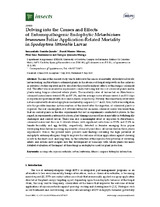Mostrar el registro sencillo del ítem
Delving into the Causes and Effects of Entomopathogenic Endophytic Metarhizium brunneum Foliar Application-Related Mortality in Spodoptera littoralis Larvae
| dc.contributor.author | Garrido-Jurado, Inmaculada | |
| dc.contributor.author | Montes-Moreno, David | |
| dc.contributor.author | Sanz-Barrionuevo, Pilar | |
| dc.contributor.author | Quesada-Moraga, Enrique | |
| dc.date.accessioned | 2020-07-09T11:09:33Z | |
| dc.date.available | 2020-07-09T11:09:33Z | |
| dc.date.issued | 2020 | |
| dc.identifier.uri | http://hdl.handle.net/10396/20302 | |
| dc.description.abstract | The aim of the current study was to delve into the causes of mortality of Spodoptera littoralis larvae feeding on Metarhizium-colonized plants in the absence of fungal outgrowth on the cadavers as previous studies reported and to elucidate the possible indirect effects of this fungus-colonized diet. The effect was evaluated in experiments conducted using leaf discs of colonized plants and in planta using fungus-colonized whole plants. The mortality rates of larvae fed on Metarhiziumcolonized melon leaves were 45.0% and 87.5%, and the average survival times were 6.6 and 3.1 days in experiments performed with discs and in planta, respectively. Notably, these mortality levels were not associated with observed apoptosis mediated by caspases 1, 3-7 and 8; thus, further investigation into the possible immune system reaction of the insect after the ingestion of colonized plants is required. The leaf consumption of S. littoralis larvae fed on melon-colonized leaves was lower than that on control plants in the disc experiments but not in experiments conducted in planta. In this regard, in experiments performed in planta, plant damage increased larval mortality in both fungally challenged and control larvae. There was also a meaningful effect of exposure to Metarhiziumcolonized melon leaf discs on S. littoralis fitness, with significant reductions in 39.0% and 22.0% in female fecundity and egg fertility, respectively, detected in females emerging from pupae developing from larvae surviving exposure to colonized plant discs; all larvae died in the in planta experiments. Hence, the present work presents new findings revealing the high potential of endophytic entomopathogenic fungi to improve the outcome of foliar applications against chewing insects in the short, mid- and long term, by the reduction of the reproductive potential of surviving adults and reveals new insights into the development of bioassays with whole plants for more detailed evaluation of the impact of these fungi as endophytes used for plant protection. | es_ES |
| dc.format.mimetype | application/pdf | es_ES |
| dc.language.iso | eng | es_ES |
| dc.publisher | MDPI | es_ES |
| dc.rights | https://creativecommons.org/licenses/by/4.0/ | es_ES |
| dc.source | Insects 11(7), 429 (2020) | es_ES |
| dc.subject | Ascomycete | es_ES |
| dc.subject | Mycoinsecticide | es_ES |
| dc.subject | Cotton leafworm | es_ES |
| dc.subject | Fitness | es_ES |
| dc.subject | Caspase | es_ES |
| dc.subject | Tritrophic interaction | es_ES |
| dc.title | Delving into the Causes and Effects of Entomopathogenic Endophytic Metarhizium brunneum Foliar Application-Related Mortality in Spodoptera littoralis Larvae | es_ES |
| dc.type | info:eu-repo/semantics/article | es_ES |
| dc.relation.publisherversion | http://dx.doi.org/10.3390/insects11070429 | es_ES |
| dc.relation.projectID | Junta de Andalucía. FEDER 2014–2020 | es_ES |
| dc.rights.accessRights | info:eu-repo/semantics/openAccess | es_ES |

